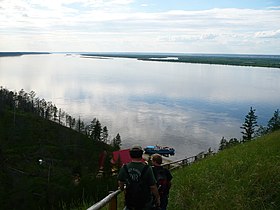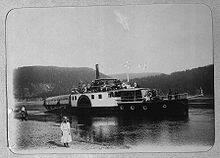| Revision as of 01:28, 4 October 2010 editJonas Poole (talk | contribs)3,656 edits →History← Previous edit | Revision as of 08:47, 4 October 2010 edit undoGreyhood (talk | contribs)Autopatrolled, Pending changes reviewers, Rollbackers91,196 edits Undid revision 388583076 by Jonas Poole (talk) see my talk pageNext edit → | ||
| Line 105: | Line 105: | ||
| The majority of researchers believe that the name of the river Lena has been acquired from the original ] name ''Elyu-Ene'', which means "the Large River". | The majority of researchers believe that the name of the river Lena has been acquired from the original ] name ''Elyu-Ene'', which means "the Large River". | ||
| ] | ] | ||
| ⚫ | In 1620-23 Russians under the leadership of ] sailed up ], discovered the proximity of Lena and either carried their boats there or built new ones. In 1623 Pyanda explored some 2400 kilometers of the river from its upper rocky part to its wide flow in the central ].<ref> {{ru icon}}</ref> In 1628 Vasily Bugor and ten men reached the Lena, collected yasak from the natives and founded ] in 1632. In 1631 the voyevoda of ] sent ] and twenty men to found an ] at ] (founded in 1632). From Yakutsk other expeditions spread out to the south and east. The Lena delta was reached in 1633. | ||
| ⚫ | |||
| ], accompanied by Alexander von Bunge, carried out an expedition to the Lena delta area and the islands of New Siberia on behalf of the Russian Imperial Academy of Sciences in 1885. They explored the Lena delta with its multitude of arms that flow towards the Polar sea. Then in spring 1886 they investigated the ] and the ] and its tributaries. During one year and two days the expedition covered 25,000 km, of which 4,200 km were up rivers, carrying out geodesic surveys en route. | ], accompanied by Alexander von Bunge, carried out an expedition to the Lena delta area and the islands of New Siberia on behalf of the Russian Imperial Academy of Sciences in 1885. They explored the Lena delta with its multitude of arms that flow towards the Polar sea. Then in spring 1886 they investigated the ] and the ] and its tributaries. During one year and two days the expedition covered 25,000 km, of which 4,200 km were up rivers, carrying out geodesic surveys en route. | ||
Revision as of 08:47, 4 October 2010
Template:Geobox The Lena (Template:Lang-ru; Template:Lang-sah, Ölüöne) is the easternmost of the three great Siberian rivers that flow into the Arctic Ocean (the other two being the Ob River and the Yenisei River). It is the 11th longest river in the world and has the 9th largest watershed. It is the greatest Russian river with its watershed entirely within national ranges.
Course

Rising at the height of 1,640 metres (5,381 ft) at its source in the Baikal Mountains south of the Central Siberian Plateau, 7 kilometres (4 mi) west of Lake Baikal, the Lena flows northeast, being joined by the Kirenga River, Vitim River and Olyokma River. From Yakutsk it enters the lowlands and flows north until joined by its right-hand affluent the Aldan River. The Verkhoyansk Range deflects it to the north-west; then, after receiving its most important left-hand tributary, the Vilyuy River, it makes its way nearly due north to the Laptev Sea, a division of the Arctic Ocean, emptying south-west of the New Siberian Islands by the Lena Delta - 30,000 square kilometres (11,583 sq mi) in area, and traversed by seven principal branches, the most important being Bykov, farthest east.
Basin

The total length of the river is estimated at 4,400 km (2,800 mi). The area of the Lena river basin is calculated at 2,490,000 square kilometres (961,394 sq mi). Gold is washed out of the sands of the Vitim and the Olyokma, and mammoth tusks have been dug out of the delta. The Lena has the unusual distinction of appearing to be the longest river in the world when viewed on a map using a Mercator projection, the most common method of displaying the spherical earth on a flat surface, due to that projection's tendency to exaggerate the size of areas near the poles (the longer Amazon and Nile rivers both cross the equator.)
Tributaries
The Kirenga River flows north between the upper Lena and Lake Baikal. The Vitim River drains the area northeast of Lake Baikal. The Olyokma River flows north. The Amga River makes a long curve southeast and parallel to the Lena and flows into the Aldan. The Aldan River makes similar curve southeast of the Aldan and flows into the Lena north of Yakutsk. The Maya River, a tributary of the Aldan, drains an area almost to the Sea of Okhotsk. The T-shaped Chona-Vilyuy River system drains most of the area to the west.
History
| Lena River from a source to Kachug |
|---|
| Legend |
The majority of researchers believe that the name of the river Lena has been acquired from the original Even-Evenk name Elyu-Ene, which means "the Large River".

In 1620-23 Russians under the leadership of Demid Pyanda sailed up Lower Tunguska, discovered the proximity of Lena and either carried their boats there or built new ones. In 1623 Pyanda explored some 2400 kilometers of the river from its upper rocky part to its wide flow in the central Yakutia. In 1628 Vasily Bugor and ten men reached the Lena, collected yasak from the natives and founded Kirinsk in 1632. In 1631 the voyevoda of Yeniseisk sent Pyotr Beketov and twenty men to found an ostrog at Yakutsk (founded in 1632). From Yakutsk other expeditions spread out to the south and east. The Lena delta was reached in 1633.
Baron Eduard Von Toll, accompanied by Alexander von Bunge, carried out an expedition to the Lena delta area and the islands of New Siberia on behalf of the Russian Imperial Academy of Sciences in 1885. They explored the Lena delta with its multitude of arms that flow towards the Polar sea. Then in spring 1886 they investigated the New Siberian Islands and the Yana River and its tributaries. During one year and two days the expedition covered 25,000 km, of which 4,200 km were up rivers, carrying out geodesic surveys en route.
Vladimir Ilyich Ulyanov took his alias, Lenin, from the river Lena, possibly because he was exiled to the Central Siberian Plateau.
Along the Lena


In the upper section west and northwest of Lake Baikal the river flows mostly north. 4400:. A small lake in the Baikal Range, in the Baikal-Lena Reserve, 10 km west of Lake Baikal, 1800m in altitude. The Lena flows north 19 km, losing 600m in altitude and becomes passable by rafts. It turns west and then south losing another 600 meters in 128 km, to Chanchur, where there is a ranger station. 4222: Kachug: start of navigation, road to Irkutsk. 4197:Verkholensk:mouth of the Kulenga River, northwest through mountains, Tutura River. 4108:Zhigalovo:start of passenger service, including hydrofoil to Ust-Kut. Canyon downstream.
In the central section the river flows mostly northeast. 3705:Ust-Kut: northwest of the northern tip of Lake Baikal. In Cossack times, this was the site of a portage between the Yenesei and Lena. Today it is the point where the Baikal-Amur Mainline railway meets the Lena and handles 80% of cargo in the Sakha Republic region. 3698:Lena: This is really a part of Ust-Kut, which is very spread out. Lena is the river port. 3397:Kirensk: port and former Cossack portage. 3101: 'The devil's path', a section treacherous in flood. 3096: Shcheki ('the cheeks'), a narrow section with cliffs and twists. Sakha Republic border. 2955:Vitim: and Vitim River from the south. We are now northeast of Lake Baikal. River widens. Many dead trees in the water. 2931:Peledui:Peledui River, ship repair company and salt mines. 2744:Lensk:the most important port between Kirensk and Yakutsk. Road 230 km north to the Mir Mine. Here was a stopping point of the 'Perlinsky Trakht', a former courier route. Lena turns southeast and then northeast. 2587:Chepaevo: 2547:Macha, 2337: Olyokminsk:, Olyokma River from the south. River widens to 2 km and has extensive flood plains. 2213:Uritskoe, 2030-1850: Lena Pillars: cliffs along the right bank. 1937:Sinsk, Sinsk River and petroglyphs. 1820:Mokhsogollokh: ferry and paved road to Yakutsk on the opposite(west) bank. River turns north. 1805:Pokrovsk: downstream:Tabaga Cliffs, narrows, power line and planned site of bridge for the Amur Yakutsk Mainline railroad. Nizhny Bestyakh: 13 km southeast of Yakutsk on the left bank, Lena Highway comes in from the south. The Kolyma Highway to the Pacific starts nearby.
In the lower section the river flows mostly north. 1710:Yakutsk:. 1560 Aldan River from the east. River tends northwest. 1373:Sangar: coal mines. 1560:Vilyuy River from the west. River tends north. 959:Arctic Circle. 939:Zhigansk,founded in 1632, 865:Agraphena Island. 545:Sikhtyakh. 385:Kyushur:regional center. 222:Lena Delta. 0:Tiksi: on the mainland east to the delta. Port, airport, two and a half month navigation season. Five degrees north of the arctic circle.
Lena Delta

At the end of the Lena River there is a large delta that extends 100 km into the Laptev Sea and is about 400 km (250 miles) wide. The delta is frozen tundra for about 7 months of the year, but in May transforms the region into a lush wetland for the next few months. Part of the area is protected as the Lena Delta Wildlife Reserve.
The Lena delta divides into a multitude of flat islands. The most important are (from West to East): Chychas Aryta, Petrushka, Sagastyr, Samakh Ary Diyete, Turkan Bel'keydere, Sasyllakh Ary, Kolkhoztakh Bel'keydere, Grigoriy Diyelyakh Bel'kee (Grigoriy Islands), Nerpa Uolun Aryta, Misha Bel'keydere, Atakhtay Bel'kedere, Arangastakh, Urdiuk Pastakh Bel'key, Agys Past' Aryta, Dallalakh Island, Otto Ary, Ullakhan Ary and Orto Ues Aryta.
Turukannakh-Kumaga is a long and narrow island off the Lena Delta's western shore.
One of the Lena delta islands, "Ostrov Amerika-Kuba-Aryta" or "Ostrov Kuba-Aryta" was named after the island of Cuba during Soviet times. It is located at the edge of its northern shoreline.
See also
- List of rivers of Russia
- List of longest undammed rivers
- William Barr, The First Soviet Convoy to the Mouth of the Lena.
- Alexander von Bunge & Baron Eduard Von Toll, The Expedition to the New Siberian Islands and the Yana country, equipped by the Imperial Academy of Sciences. 1887.
References
- "Lena River Delta - A Global Ecoregion". World Wide Fund for Nature. 2006-07-06. Retrieved 2008-05-23.
- The discovery of Central and Eastern Siberia by Russians Template:Ru icon
- numbers are kilometers from the mouth of the Lena. Source:Athol Yates and Nicholas Zvegentzon, 'Siberian BAM Guide', 1995, second edition 2001
- "Ostrov Amerika-Kuba-Aryta"
External links
- NASA Earth Observatory page on flooding on the Lena River
- Information and a map of the Lena's watershed
- Permafrost in the Lena Delta
- Student Partners Project - scientific study involving students along the Lena River
- Alfred Wegner institute (AWI) Publications, Berichte zur Polar- und Meeresforschung (Reports on polar and marine research) - free, downloadable research reports on the biology, geology, oceanography, hydrology, paleontology, paleoclimatology, fauna, flora, soils, cryology, and so forth of the Lena Delta, Laptev Sea, and other parts of the Arctic Circle.
![]() This article incorporates text from a publication now in the public domain: Chisholm, Hugh, ed. (1911). Encyclopædia Britannica (11th ed.). Cambridge University Press.
This article incorporates text from a publication now in the public domain: Chisholm, Hugh, ed. (1911). Encyclopædia Britannica (11th ed.). Cambridge University Press. {{cite encyclopedia}}: Missing or empty |title= (help)
| Shipbuilding and shipping on the river Lena | |||||||
|---|---|---|---|---|---|---|---|
| Shipbuilding |
| ||||||
| River ports |
| ||||||
| Ship types | |||||||
| Well-known vessels | |||||||
| Well-known travels | |||||||
| River accidents | |||||||
| Significant persons |
| ||||||
73°N 127°E / 73°N 127°E / 73; 127
Categories: